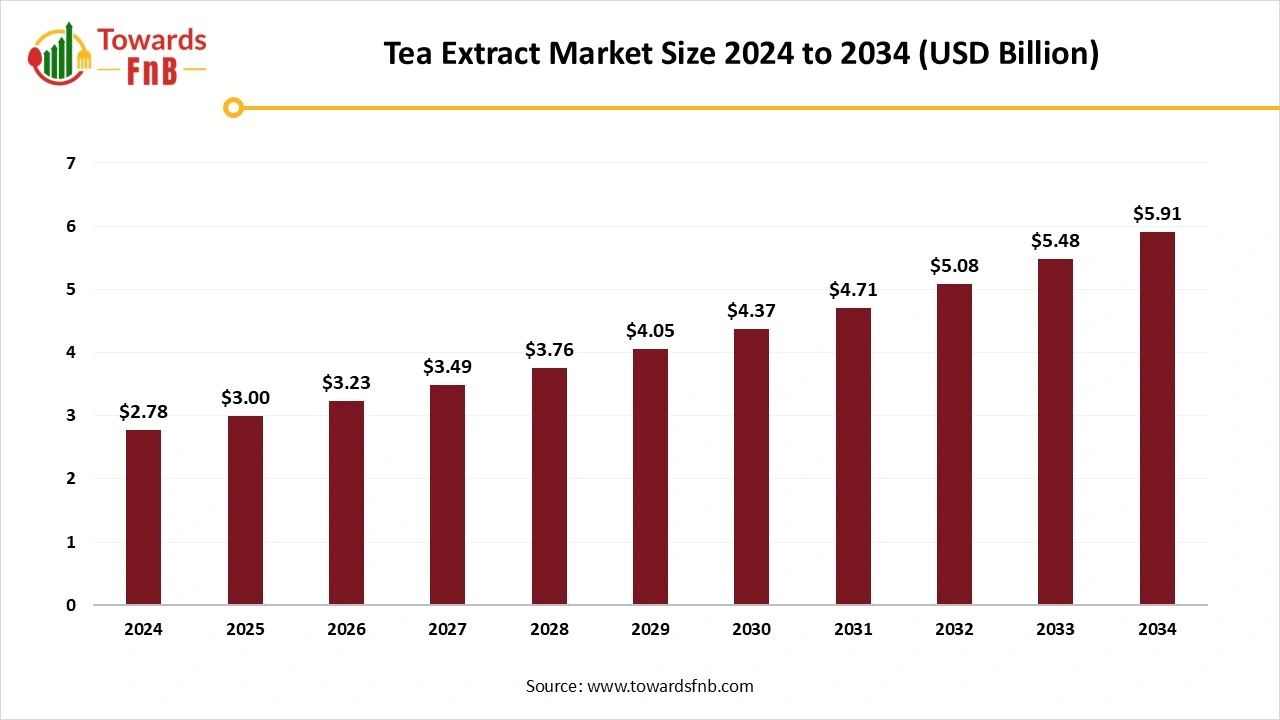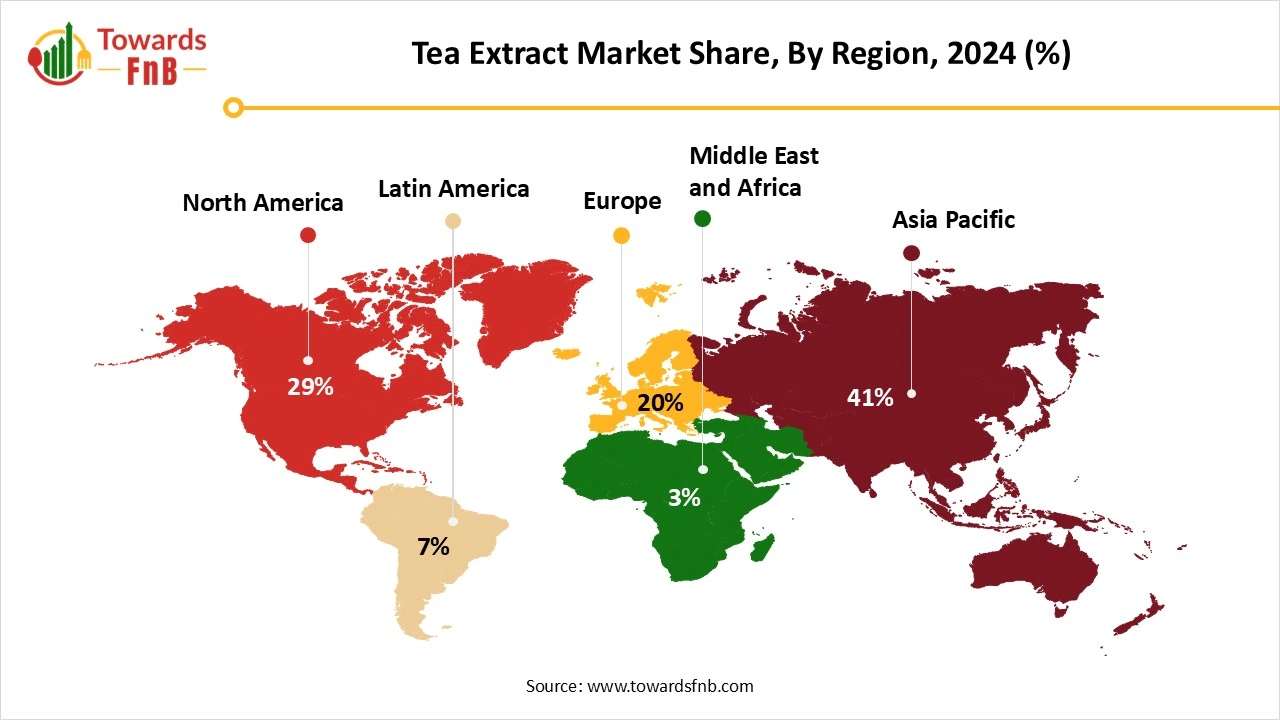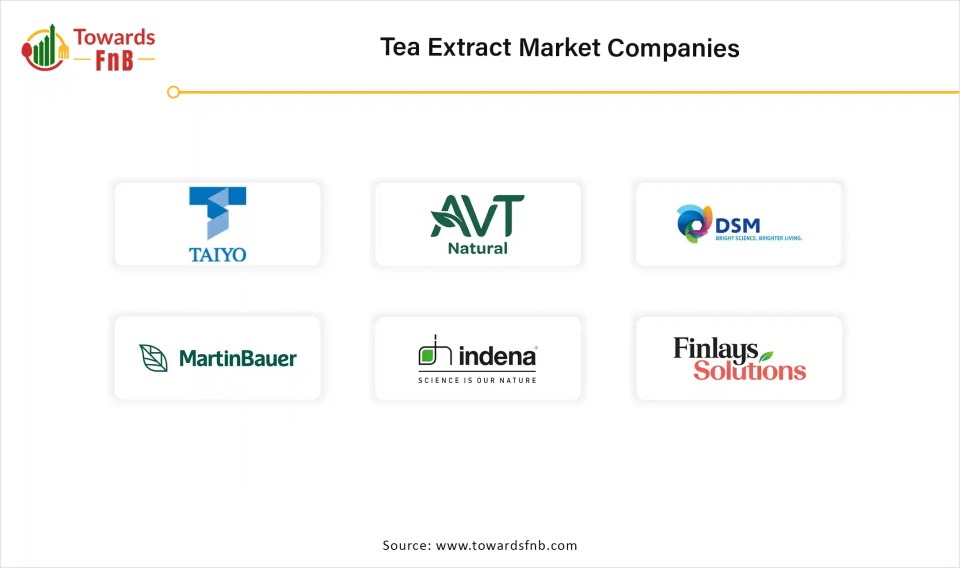December 2025
The global tea extract market size reached at USD 2.78 billion in 2024 and is anticipated to increase from USD 3 billion in 2025 to an estimated USD 5.91 billion by 2034, witnessing a CAGR of 7.83% during the forecast period from 2025 to 2034. Growing health awareness among consumer and increasing demand for the functional ingredients significantly driving the global market.

| Study Coverage | Details |
| Growth Rate from 2025 to 2034 | CAGR of 7.83% |
| Market Size in 2025 | USD 3 Billion |
| Market Size in 2026 | USD 3.23 Billion |
| Market Size by 2034 | USD 5.91 Billion |
| Largest Market | Asia Pacific |
| Base Year | 2024 |
| Forecast Period | 2025 to 2034 |
| Regions Covered | North America, Europe, Asia-Pacific, Latin America, and Middle East & Africa |
The tea extract market refers to the global industry involved in the production, processing, and commercialization of concentrated forms of tea derived from green, black, oolong, white, and herbal tea leaves. These extracts are widely used in functional beverages, dietary supplements, cosmetics, pharmaceuticals, and food flavoring applications.
Tea extracts, rich in antioxidants (e.g., catechins, polyphenols, theaflavins) and other bioactive compounds, are favored for their anti-inflammatory, anti-aging, weight management, and energy-boosting properties. As consumer preference shifts toward natural, clean-label, and plant-based products, the demand for tea extracts across industries continues to grow rapidly.
The rising need for natural, functional components in pharmaceuticals and dietary supplements presents a significant opportunity for the tea extract market. This rapid expansion creates a huge need for tea extracts as components in supplements for weight control, immune support, and cognitive health. With consumers seeking clean-label, plant-based options, tea extracts are poised to become a key component in the emerging pharmaceutical and nutraceutical sectors.
Mergers and acquisitions have emerged as a vital tactic for businesses aiming to expand their market presence. With bigger beverage brands and ingredient suppliers aiming to expand their product ranges, there has been an increase in the acquisition of smaller tea extract firms. These mergers provide companies with exposure to cutting-edge tea extraction technologies, distribution networks, and consumer audiences, thereby improving their market standing.
A significant obstacle confronting the market is the fluctuation of raw material costs. Tea is an extremely sensitive agricultural product, and changes in climate, pest infestations, and supply chain issues can result in unstable prices. This may affect the profitability of tea extract producers and pose difficulties in price stability for buyers.
Asia Pacific Dominated the Market in 2024.
Main factors propelling the expansion of the Asia Pacific tea extract market are the rising consumer inclination towards natural and clean-label items, in addition to growing awareness regarding chronic disease prevention via dietary selections. The area's varied tea culture creates a solid base for innovation, enabling producers to leverage traditional tastes while offering contemporary functional advantages. China, India, Japan, and Indonesia are the top tea markets in Asia, due to their tea traditions and production, along with substantial populations. Additionally, there has been a growing consumer interest in novel flavors, origins, and sustainability. Increasing disposable income and urban growth have resulted in a rise in the intake of fortified drinks and supplements. Additionally, changing dietary habits that promote antioxidant-loaded formulations lead to wider acceptance.

China is the biggest producer and consumer of tea globally. For instance, China mainly produces green tea. In 2023, 57.9 percent, of China's tea production consisted of green tea, with black tea following at 0.49 mmt. This green tea represents nearly 30 percent of the total global tea volume for 2023. The rest of China's tea includes dark (hei) at 13.7 percent, wulong at 10 percent, white at 3 percent, and yellow tea at 0.7 percent. The market exhibits a pronounced demand for premium tea extracts, especially within traditional Chinese medicine and the pharmaceutical sector. Manufacturers in China like Tongrentang and Yunnan Baiyao utilized tea extracts to develop medicinal products, including tea-infused health tonics and tea-based supplements. Moreover, China's burgeoning food and beverage sector, spearheaded by firms like Hangzhou Wahaha Group and Nongfu Spring, is persistently exploring fresh and innovative methods to integrate tea extracts into products, fueling expansion and creativity within the market.
North America Expects Significant Growth During the Forecast Period.
Increased demand for natural ingredients in food and beverages is driving the North America tea extracts market. Consumers are increasingly recognizing the negative impact of ingesting food and drinks containing artificial ingredients. As worries about ingredient safety and possible health impacts rise, there is a growing use of natural food additives in different kinds of food and drinks. Moreover, the increasing popularity of specialty teas, like herbal and green varieties, has boosted the demand for tea in the area. A significant trend in the North American tea market is the growth of ready-to-drink tea. Ready-to-drink tea provides ease and portability, making it an appealing choice for consumers in a hurry. The availability of numerous flavors and types of RTD tea has further fueled its popularity. A growing trend is the rising popularity of organic and natural teas. Consumers are increasingly aware of the contents in their food and drinks and are ready to spend more on items that are devoid of synthetic
The tea extract market in the United States has seen substantial growth, fueled by rising consumer interest in healthier beverage options. tea extract, recognized for its antioxidant qualities and possible health advantages, is gaining popularity across multiple sectors such as food and drinks, cosmetics, and pharmaceuticals. The growing interest in natural and organic components in products has fueled the market's growth. Moreover, the increasing recognition of the health advantages of tea extract, including enhanced heart health and weight control, has propelled its market expansion. The market is anticipated to keep expanding as consumers look for healthier options. Advancements in product formulations and uses further improve the market perspective. By 2024, the United States held the top position in worldwide exports of tea extract. The United States represents around 82.96% of the worldwide export value of tea extract, with an export value totaling 172,089,251 USD. The leading countries purchasing tea extract from the United States are World, Mexico, Canada, the Netherlands, and Vietnam.
How Green Tea Extract Segment Dominated the Tea Extract Market in 2024?
Green tea extract segment led the tea extract market in 2024. Green tea is the most popular type of tea, due to increasing health consciousness and the growing prevalence of chronic illnesses. Green tea extract is a derivative obtained from the leaves of green tea. The leaves of green tea have the highest concentration of the active catechin, EGCG. It is widely considered the Nutraceuticals of contemporary life because of its antioxidant properties. Consumers have become more knowledgeable about natural health products and seek functional drinks as cosmetics and pharmaceuticals broaden their uses.
Herbal tea extracts (hibiscus, rooibos, etc.) segment is seen to grow at significant rate during the forecast period.
With consumers progressively shifting towards natural wellness items and functional beverages, the industry keeps expanding, with herbal tea becoming a favored alternative to traditional tea and caffeinated drinks. As the demand for herbal tea grows, particularly for organic and functional varieties, producers are enhancing their manufacturing capabilities. Industries such as personal care & cosmetics, food & beverages, and nutraceuticals favor natural, eco-conscious, and organic components. This consequently stimulates the demand, thus propelling the market's growth for them throughout the forecast period.
Which Form of the Tea Extract Dominated the Tea Extract Market in 2024?
Powder segment held the dominating share of the tea extract market in 2024. The segment of powdered tea extract leads the market because of its adaptability, convenience in handling, and long shelf life, which makes it suitable for numerous uses in the food, beverage, and pharmaceutical sectors. Powdered extracts provide an easy way to include them in items such as dry mixes, capsules, and tablets, and they dissolve easily while having a longer shelf life than liquid extracts.
Liquid Segment is Seen to Grow at a Notable Rate During the Predicted Timeframe.
The liquid segment of the market is witnessing swift expansion owing to its adaptability and ease of use, especially in ready-to-drink drinks and functional food products. This expansion is driven by rising consumer desire for ready-to-use formats, the ease of integrating liquid extracts into different products, and the belief that liquid extracts are more natural and fresher.
What Made Conventional Tea Extract the Dominant Segment in 2024?
Conventional segment dominated the market with the largest share in 2024. This dominance is mainly due to the established farming methods and the broad accessibility of traditionally grown tea leaves, which have historically been the main source for tea extract production. The established supply chain and typically reduced production costs linked to traditional agriculture have led to a greater availability of conventional tea extracts in the marketplace.
Organic Segment is Expected to Grow at the Fastest Rate in the Market During the Forecast Period.
The increasing focus on health and wellness along with the rising inclination towards natural and organic products is greatly enhancing demand. Shoppers are actively looking for clean-label items and are ready to pay extra for organic certification, indicating no synthetic pesticides or chemicals are present. The higher costs linked to organic products, combined with the increasing emphasis on ethical sourcing and sustainable farming methods, have further enhanced this sector. Consequently, businesses are pouring resources into the organic tea extract market, creating novel products to meet the changing tastes of health-aware consumers globally.
Why did the Functional Beverages Segment Dominate in 2024?
Functional beverages segment held the largest share of the market in 2024. The rise in the consumption of nutritious beverages rich in essential nutrients to tackle various health concerns is increasingly common among consumers, leading to the expansion of the functional drinks market. Tea extracts are incorporated in ready-to-drink teas and health-focused drinks, for their antioxidant properties and flavor improvement, targeting health-aware consumers. The growth of this segment is supported by novel product formulations and the increasing demand for clean labels and organic items.
Dietary Supplements & Skincare Products Segment is Observed to Grow at the Fastest CAGR During the Forecast Period.
Consumers are progressively looking for natural options instead of synthetic products. Tea extracts are being used in different supplement formats such as capsules, tablets, and powders, providing consumers easy methods to boost their daily nutrient consumption and promote preventive health. Consumers are moving towards plant-derived and organic beauty items, with tea extracts like black tea, green tea, white tea, and matcha gaining popularity for their anti-inflammatory, anti-aging, and detoxifying benefits. These components are rich in polyphenols and catechins, which together assist in combating oxidative stress, reducing skin irritation, and enabling adequate skin hydration. The trend of wellness as a significant influencing factor will contribute to the industry's growth as well.
Which Distribution Channel Dominated the Tea Extract Market in 2024?
B2B direct supply segment led the market in 2024. Businesses in this sector benefit from the increasing desire for functional foods and drinks, particularly among health-oriented customers. Partnerships with global companies and beverage manufacturers that incorporate tea extracts in ready-to-drink teas, supplements, and cosmetic products can enhance B2B sales. The strength of this channel is enhanced by manufacturers' ability to ensure consistent quality and customization, which is vital for uses in pharmaceuticals and nutraceuticals.
Online Retail Segment is Seen to Grow at a Notable Rate During the Predicted Timeframe.
The ease of online shopping enables customers to explore and buy numerous tea items from the comfort of their residences, whenever they wish. Online shopping sites provide comprehensive product information, user feedback, and a wider variety of teas, featuring specialty and global brands that might not be found in nearby shops. Moreover, e-commerce shops typically offer attractive prices, promotions, and subscription options, making it easier for customers to discover and consistently buy their preferred teas.
NutraTea
Tetley
PG Tips

By Type
By Form
By Nature
By Application
By Distribution Channel
By Region
December 2025
December 2025
December 2025
December 2025